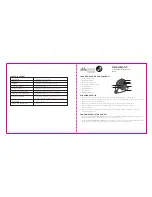
4
CONGRATULATIONS ON AN EXCELLENT
CHOICE!
Peltor headsets are tested and approved according to PPE directive
89/686/EEC and EMC directive 89/336/EEC, which means that
they meet the demands for CE marking. Read these instructions
carefully to ensure the best possible benefit from your Peltor
product.
A) SPECIALLY DESIGNED HEADSET
Properties
1a. Extra broad headband
(MT53H79A-**) with soft padding for
ideal comfort throughout the working day.
1b. Helmet attachment
(MT53H79P3E-**) for all regular helmet
types. Peltor’s helmet, visor and rain protector fit this helmet
attachment.
2. Individually sprung headband wires
of stainless steel
provide an even distribution of pressure around the ears.
Steel headband wires maintain their resilience better than
regular plastic headbands through a wide range of
temperatures.
3. Low, two-point fasteners
and easy height adjustment with
no protruding parts.
4. Soft, wide foam-filled ear cushions
with built-in pressure-
relief canals for low pressure, effective sealing and ideal
comfort.
5. Specially selected earphones
, which provide excellent
sound reproduction even in noisy environments.
6. Cable
with connecter.
7. Electret microphone
with high noise suppression. Easy to
replace because they connect with an external connecter.
8. PTT/reply button
built into the shell.
MT53H79*-21 for Motorola GP300
MT53H79*-31 for Icom etc.
MT53H79*-32 for Motorola GP340
Specially designed headset with PTT button built into the left
shell. The headset is fitted with two 30
Ω
parallel connected
earphones.
Weight: MT53H79A-** 30 g, MT53H79B-** 30 g,
MT53H79P3E-** 345 g.
MT53H79*-28 for some DECT and mobile phones
Specially designed headset with hook on/hook off button built
into the left shell; works only with certain models. The headset
is equipped with two 30
Ω
parallel connected earphones and a
0.5–.4-m soft spiral polyurethane cable with moulded .5-mm
connecter. Telephones that do not have .5-mm connecters require
adapters. Weight: MT53H79A-8 30 g.
MT53 MICROPHONE
Type: Electret differential microphone
Frequency range: 70–0000 Hz ± 6 dB
Sensitivity as a lip microphone: 5 mV/680
Ω
Impedance: >680
Ω
Noise suppression: 5 dB at kHz
NOTE:
The microphone is polarised. When replacing the micro-
phone, connect the connecter with the wire forward.
HTS-230 EARPHONE
Type: Dynamic
Impedance: 30
Ω
Frequency range: 5–8000 Hz
Output level at 0.5 V/ kHz: 8 dBA
C) ASSEMBLY/CONFIGURATION
Headband A (Fig. C)
(C:) Slide out the cups. Place the headset over your ears so that
the ear cushions fit snugly.
(C:) Adjust the cups to a snug, comfortable fit by pulling the cup
up or down while pressing the headband down.
(C:3) The headband should lie across the top of the head.
P3E Helmet attachment (Fig. E)
(E:) Snap the helmet attachment into the slot on the helmet.
Note:
The cups can be set in three positions:
Working position (E:), ventilation position (E:3) and parked
position (E:4). When in use, the cups must be placed in work-
ing position. Press the headband wires inwards until you hear a
click on both sides. Ensure that the cup and the headband wires
in working mode do not bump or snag on anything so that noise
leakage can occur. Do not use parking position if the cups are
damp inside after intensive use.
IMPORTANT USER INFORMATION
100% use of a working hearing protector is the only sure protec-
tion from hearing loss.
If you spend time in environments with more than 85 dB A-weighted
noise, you need to protect your hearing, because the hearing
receptors deep in your ears may be irreparably damaged. If you
remove the protectors for even a tiny portion of the time you spend
in noisy situations, you are in the danger zone. A comfortable
hearing protector designed for the specific noise level in which it is
used is the best guarantee that you will wear the hearing protector
00% of the time, thereby ensuring protection from permanent
hearing loss.
• For the best protection, brush aside hair around the ears so
the ear cushions fit snugly against the head. Spectacle
frames should be as thin as possible and fit close to the head.
• For maximum noise compensation, the microphone must be
placed 3 mm in front of the lips.
• Clean the outside of the headset regularly with soap and
warm water.
Note: Do not immerse in water!
• Even high-quality headsets can wear out over time. Inspect
the headset regularly to make sure there are no cracks or
leakage, which will reduce the hearing protection. If the head-
set is used continuously, check the ear cushions often.
• Do not store the headset at temperatures in excess of +55ºC,
for example in the sun or inside a windscreen or window!
• Certain chemical substances may be harmful to this product.
Connect the manufacturer for more information.
F) USAGE TIME/INPUT SIGNAL
The audio signal in the earphones should be adapted to the usage
time. To prevent harmful levels, the input signal must not exceed
the values in diagram
F
.
G) ATTENUATION VALUES
The headset is tested and approved according to PPE directive
89/686/EEC and applicable parts of European standard EN 35-
:993. Certificate issued by the Department of Physics, Finnish
Institute of Occupational Health, Topeliuksenkatu 4, FI-0050
Helsinki, Finland. ID#0403.
Explanation of the attenuation value table:
) Frequency in Hz.
) Average attenuation value in dB. 3) Standard deviation in dB.
4) Average Protection Value.
EN
Содержание MT53
Страница 1: ...Peltor Headset MT53 ...
Страница 2: ...C C 1 E E 2 E 3 E 4 E 1 C 2 C 3 A 2 3 4 5 6 7 1 a 1 b 8 ...
Страница 34: ...32 ...
Страница 35: ......







































